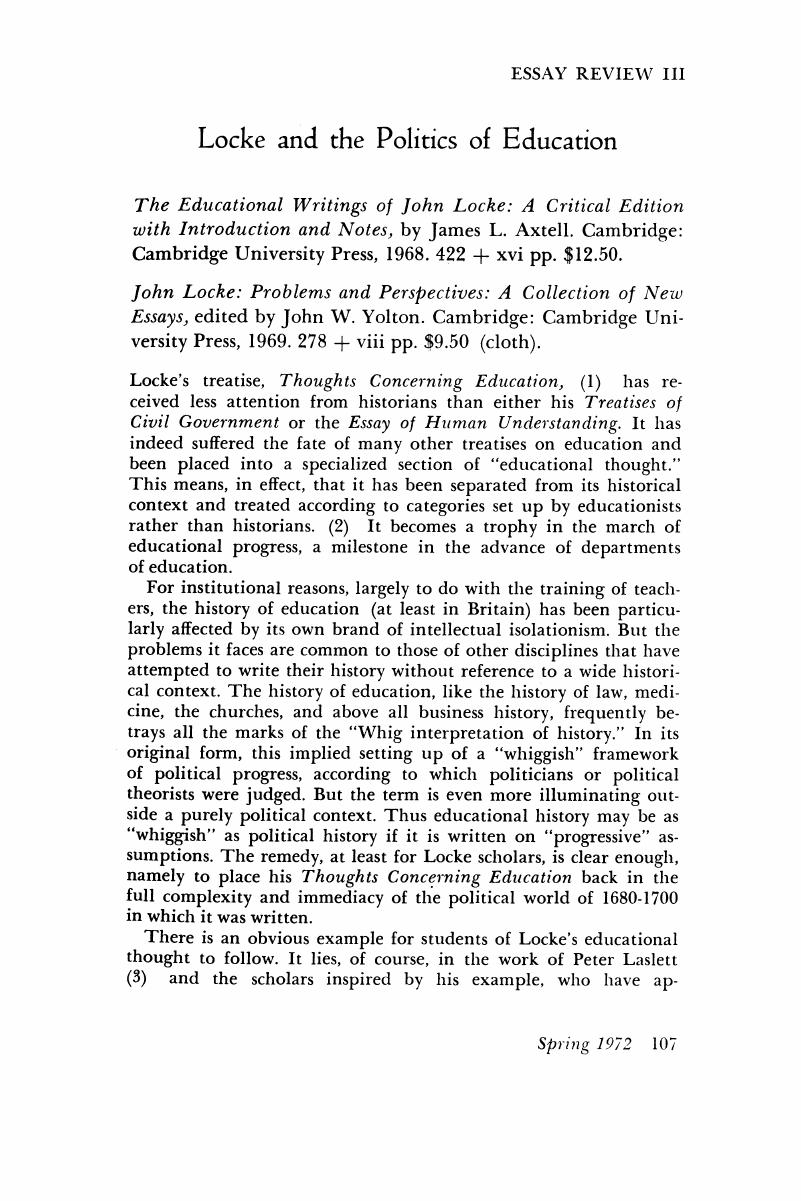Article contents
Locke and the Politics of Education
Published online by Cambridge University Press: 24 February 2017
Abstract

- Type
- Essay Review III
- Information
- Copyright
- Copyright © 1972 by New York University
References
Notes
1. Hereafter referred to as Education. I am grateful to my colleague, Dickinson, Dr. Harry, for a number of helpful suggestions.Google Scholar
2. The generalization, though still broadly true, is less so in 1971 than in 1961. The latest and outstanding exception is Cremin, Lawrence, American Education: The Colonial Experience (New York, 1971).Google Scholar
3. In particular, Peter Laslett's critical edition of Locke's Two Treatises of Civil Government (New York and London, 1960).Google Scholar
4. Yolton, John W., ed., John Locke: Problems and Perspectives: A Collection of New Essays (Cambridge, 1968).Google Scholar
5. Axtell, James L., The Educational Writings of John Locke: A Critical Edition with Introduction and Notes (Cambridge, 1968).Google Scholar
6. Yolton, , Locke, p. 182.Google Scholar
7. Axtell, , Educational Writings, p. 58.Google Scholar
8. See also, of course, Professor Plumb, J. H., The Growth of Political Stability in England, 1675–1725 (London, 1967).Google Scholar
9. Kearney, Hugh, Scholars and Gentlemen: Universities and Society in Pre-Industrial Britain, 1500–1700 (Ithaca, 1970).Google Scholar
10. Ibid., p. 158.Google Scholar
11. Stone, Lawrence, “The Ninnyversity,“ New York Review of Books (January 28, 1971).Google Scholar
12. Holmes, Geoffrey S., British Politics in the Age of Anne (New York, 1967), p. 170.Google Scholar
13. Pocock, J. G. A., “Machiavelli, Harrington and English Political Ideologies in the Eighteenth Century,“ William and Mary Quarterly 22 (October 1965): 575.Google Scholar
14. Holmes, , British Politics, p. 182.Google Scholar
15. Holmes, , British Politics, p. 172.Google Scholar
16. Dickinson, H. T., “Henry St. John and the Struggle for Leadership of the Tory Party, 1702–1714“ (Ph.D. diss., University of Newcastle-upon-Tyne, 1968), p. 104.Google Scholar
17. Bennett, G. V., “Conflict in the Church,“ in Britain After the Glorious Revolution, ed. Holmes, Geoffrey S., (New York and London, 1969), p. 163.Google Scholar
18. Ibid., p. 164.Google Scholar
19. Cranston, Maurice, John Locke: A Biography (London and New York, 1957), pp. 214–15.Google Scholar
20. Axtell, , Educational Writings, p. 4.Google Scholar
21. Burton, Ivor Flower, Riley, W. J., and Rowlands, E., Political Parties in the Reigns of William III and Anne: The Evidence of Division Lists. Bulletin of the Institute of Historical Research, special supplement, no. 7. (London, November 1968).Google Scholar
22. Rand, Benjamin, The Correspondence of John Locke and Edward Clarke (London, 1927), p. 43.Google Scholar
23. Ibid., p. 440.Google Scholar
24. Ibid. See also Laslett, Peter, “John Locke: The Great Recoinage and Origins of the Board of Trade, 1695–1698.“ in Yolton, John Locke, pp. 137–13.Google Scholar
25. Axtell, , Educational Writings, p. 355.Google Scholar
26. Ibid., p. 358.Google Scholar
27. Ibid., p. 320.Google Scholar
28. Ibid., p. 383–84.Google Scholar
29. Holmes, , Britain After the Glorious Revolution, p. 145.Google Scholar
30. Axtell, , Educational Writings, p. 360.Google Scholar
31. Kramnick, I., Bolingbroke and His Circle: The Politics of Nostalgia in the Age of Walpole (Cambridge, 1968), pp. 61–63, 98, 117.Google Scholar
32. Ibid., p. 191, 197–98.Google Scholar
33. Defoe, Daniel, Complete English Gentleman, ed. Bulbring, K. D., (1890), pp. 19, 36, 198, 245, 247, 257.Google Scholar
- 1
- Cited by


